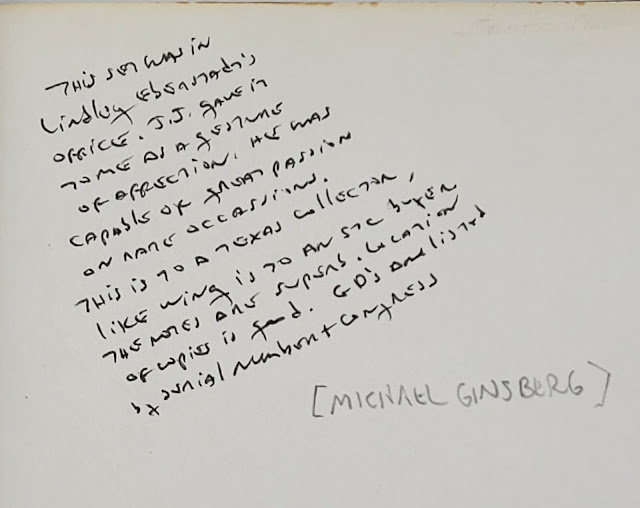Edward Eberstadt. TYPED LETTER SIGNED TO THOMAS STREETER. April 23, 1936. Letterhead of Edward Eberstadt, 55 West 42nd Street, New York. 1 p. 4to. [with] Howard M. Ballou and George R. Carter “The History of the Hawaiian Mission Press, with a Bibliography of the Earlier Publications,” in Papers of the Hawaiian Historical Society No. 14, 1908, pp. [9]-42. 8vo. Printed wrappers. The bibliography includes a couple of annotations by Streeter. This exciting find was plucked by me from a miscellaneous group of pamphlets and ephemera at Willis Monie Books, Cooperstown, NY in 2024.
“Ballou, who wrote this, was a very dear friend of mine, but he has now passed into the beyond. Carter, who collaborated with him (allegedly) was Governor of Hawaii. Governor Carter brought together the finest collection of Hawaiiana every assembled, and Ballou made and printed a very interesting bibliography of it. I think Carter is dead too. The point is, both live in books and bibliography. Take heed!”
And Thomas Streeter certainly did take heed, producing the monumental Bibliography of Texas 1795-1845 (1955-1960).
Which leads us to this recently acquired association set…
Thomas Streeter. BIBLIOGRAPHY OF TEXAS 1795-1845. PART I. TEXAS IMPRINTS. . . PART II. MEXICAN IMPRINTS. . . PART III. UNITED STATES AND EUROPEAN IMPRINTS. Cambridge: Harvard University Press, 1955-1960. 5 vols. lxxi 259 + [v] 263-616 + xxiv 283 + xlii 278 + xlii 278 p. Plates. 8vo. Contemporary full leather, spines stamped in gilt, raised bands.
The Eberstadt Co. – John Jenkins – Michael Ginsberg set. Ginsberg writes on the ffep, “This set was in
Lindley Eberstadt’s office. J[ohn] J[enkins] gave it to me as gesture of
affection. He was capable of great
passion on rare occasion.”
The Eberstadt
Company (Edward and sons Lindley & Charles) were major suppliers of
rarities to Streeter for decades. They
also brokered the sale of Streeter’s Texas collection to Yale. Michael Vinson writes in Edward Eberstadt
& Sons, “Thomas W. Streeter’s passing on June 12, 1965, meant to the
Eberstadt’s not only the loss of a great friend and customer but the end of an
era of Americana collecting. . . Since Streeter was a customer of the
Eberstadt’s from the early 1920s, it was only natural that Charles and Lindley.
. . would help organize and select items for the Parke-Bernet Galleries to
feature in the [Streeter] sales.”
In 1975, thirty-five-year-old Texas bookseller John Jenkins purchased
the remaining stock of the Eberstadt Company, after a lengthy courtship and
negotiations with primarily Lindley Eberstadt.
Jenkins writes in detail of the blockbuster acquisition in “The
Eberstadt Caper,” in Audubon and Other Capers (1976):
“By this time [1975] it was clear to me that it was all or nothing with
Lindley on the stock; there would be no picking and choosing. In April he finally let me come to see what I
had dreamed of seeing for so many years. I brought Michael Ginsberg, an
Americana expert, with me to help evaluate.
Lindley and I talked price awhile—I bluffed about being able to raise
the money, and Lindley knew I was bluffing.
For exactly one hour Mike and I looked at the stock. We added up random shelves and multiplied by the
total number of shelves. We averaged the
cheapest with the rarest books. Each way
we figured it, the total value came to ten million dollars or more. We could hardly believe it. I told Lindley I would be back in touch and
he said fine. . . On August 6, we all
met in New York. Our side had agreed to
put up the entire [purchase] amount in advance, in escrow, to be paid over half
a dozen years, with stiff interest. . .
“The packers never showed up.
All afternoon, all evening, all night, all morning the next day, all
afternoon and into the evening—34 non-stop hours Mike, Lt. Scott, and I
carefully packed 670 crates containing 41,000 fragile rare books. At midnight the truck arrived. The loaders also failed to show. For five more hours the three of us loaded
the crates into the truck, ever so carefully.
We crawled into our station wagon and drew lots for who would get the
first four-hour sleep shift in the back seat.
For 41 more consecutive hours we followed the Allied van and played
games with our walkie-talkies, stopping occasionally for a bite to eat or call
in to Texas at various check points. . .
I had a strange nightmare [about Nixon].
‘Let go, let go, Tricky Dick!’ I screamed as I awoke, nearly causing
Ginsberg to drive off the road. . .
“It was an unbelievable collection. The Texas materials, gathered over a sixty-year period, were extraordinary. Added to what the Eberstadts had accumulated were many pieces from the famous Thomas W. Streeter Collection. The Streeter Texas Collection had been sold to Yale, but the Eberstadts (who brokered the sale) got many of the items from Streeter’s collection that duplicated what Yale already had. The Eberstadts also were instrumental in arranging the Streeter auctions, and were heavy purchasers in those seven unforgettable record setting sales. In the several thousand Texas items we acquired were hundreds of works listed in Streeter’s Bibliography of Texas, and hundreds more that were unlisted and formerly unknown.”
Jenkins would retain Mike Ginsberg as a consultant after the
collection’s arrival. Vinson tells an
expanded version of the Eberstadt caper utilizing an interview with Ginsberg in
Bluffing
Texas Style (2020).
 |
| Michael Ginsberg's note in the Eberstadt-Jenkins-Ginsberg set of Streeter's Bibliography of Texas |


Pretty cool to find those two items!
ReplyDelete